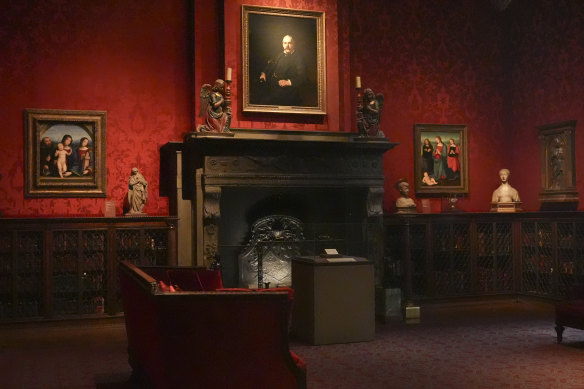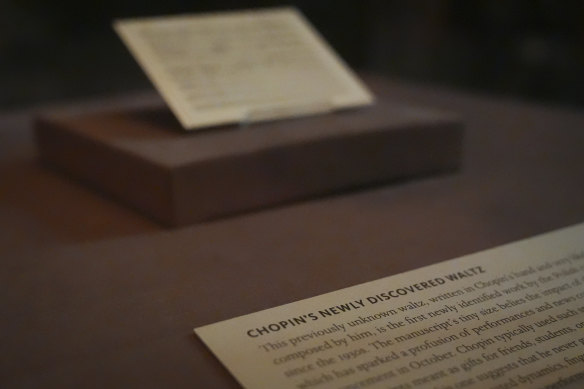
McClellan then worked with experts to verify its authenticity.
The paper was found to be consistent with that Chopin favoured for manuscripts, and the ink matched a kind typical in the early 19th century when Chopin lived, according to the museum. But a handwriting analysis determined the name “Chopin” written at the top of the sheet was penned by someone else.

A previously unknown musical manuscript, possibly by Frederic Chopin, rests in a display case.Credit: AP
Born in Poland, Chopin was considered a musical genius from an early age. He lived in Warsaw and Vienna before settling in Paris, where he died in 1849 at the age of 39, probably of tuberculosis.
He is buried among a pantheon of artists at the city’s famed Pere Lachaise Cemetery, but his heart, pickled in a jar of alcohol, is housed in a church in Warsaw, in keeping with his dying wish for it to return to his homeland.
Artur Szklener, director of the Fryderyk Chopin Institute in Warsaw, the Polish capital where the composer grew up, agreed that the document is consistent with the kinds of ink and paper Chopin used during his early years in Paris.
Loading
Musically, the piece evokes the “brilliant style” that made Chopin a luminary in his time, but it also has features unusual for his compositions, Szklener said.
“First of all, it is not a complete work, but rather a certain musical gesture, a theme laced with rather simple piano tricks alluding to a virtuoso style,” Szklener explained in a lengthy statement released after the document was revealed last month.
He and other experts conjecture the piece could have been a work in progress. It may have also been a copy of another’s work, or even co-written with someone else, perhaps a student for a musical exercise.
Jeffrey Kallberg, a University of Pennsylvania music professor and Chopin expert who helped authenticate the document, called the piece a “little gem” that Chopin probably intended as a gift for a friend or wealthy acquaintance.
“Many of the pieces that he gave as gifts were short – kind of like ‘appetisers’ to a full-blown work,” Kallberg said in an email. “And we don’t know for sure whether he intended the piece to see the light of day, because he often wrote out the same waltz more than once as a gift.”
David Ludwig, dean of music at The Juilliard School, a performing arts conservatory in Manhattan, agreed the piece has many of the hallmarks of the composer’s style.
“It has the Chopin character of something very lyrical and it has a little bit of darkness as well,” said Ludwig, who was not involved in authenticating the document.

Signage describing the find as “Chopin’s newly discovered waltz”.Credit: AP
But Ludwig noted that, if it’s authentic, the tightly composed score would be one of Chopin’s shortest known pieces. The waltz clocks in at under a minute when played on piano, as many of Chopin’s works were intended to be.
“In terms of the authenticity of it, in a way it doesn’t matter because it sparks our imaginations,” Ludwig said. “A discovery like this highlights the fact that classical music is very much a living art form.”
In September, a previously unknown piece likely composed by a young Wolfgang Amadeus Mozart was uncovered in one of Germany’s library collections.
AP
Get a note directly from our foreign correspondents on what’s making headlines around the world. Sign up for our weekly What in the World newsletter.









 Add Category
Add Category